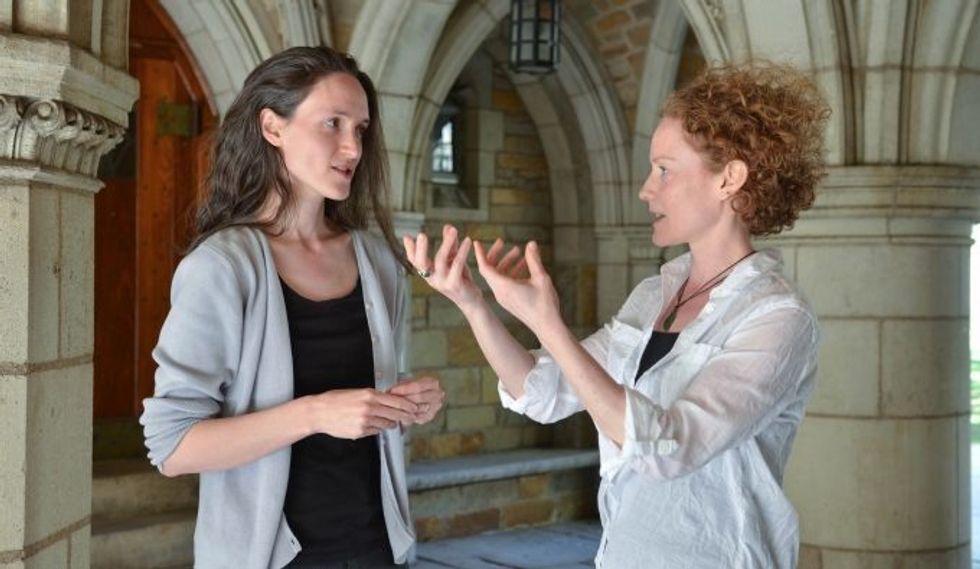Are Dancers Secretly Physicists in Disguise?
Back in 2011, Yale University’s dean of science was thinking about refreshing the program’s offerings for non-majors when he happened upon a Pilobolus performance. A light bulb went off: Dance is full of physics.
That realization led to what has become an eight-year collaboration between particle physicist Sarah Demers and former New York City Ballet dancer Emily Coates, both professors at Yale who were brought together to co-teach a course called The Physics of Dance. Their partnership has involved everything from directing a short film to presenting a TedX Talk and performing a piece that Coates created, commissioned by Danspace Project. This month, they’re publishing a book about what they’ve discovered by dialoging across two seemingly disparate disciplines.
 Sarah Demers and Emily Coates. Photo by Michael Marsland, Courtesy Yale University
Sarah Demers and Emily Coates. Photo by Michael Marsland, Courtesy Yale University
Their work together has one rule: They give equal respect to both disciplines, presenting each as complexly as possible. “We didn’t want one discipline to lead over the other,” says Coates. “We’re constantly moving back and forth to think about how one illuminates the other, how they connect and the vast differences between modes of thinking.”
Of course, equality is easier said than done.
“I remember first hearing the phrase ‘movement research’ from Emily and being a little bit skeptical,” says Demers, whose only previous experience with dance was a year and a half of ballet classes as a preteen. “What do you mean by movement research? Are you moving your body in ways that no one has ever moved? What’s your research outcome?”
A couple months later, a grad student asked Demers if some of the supporting work he was doing for his thesis could be considered research. “I realized, Wow, it never occurred to me to question what I mean by research in physics. But I made the dancer defend for me what her research was.”
These kinds of strokes of insight have happened many times. “I’ve realized I’ll learn more about my own field when I don’t make assumptions, but see it with as critical of an eye as I would with something I’m not exposed to,” adds Demers.
 Coates and Demers at Danspace. Photo by Ian Douglas, Courtesy Danspace
Coates and Demers at Danspace. Photo by Ian Douglas, Courtesy Danspace
They’ve also realized just how much the two fields can illuminate one another.
For instance, dance allows physicists to have a kinesthetic encounter with their subject matter. “Newton’s laws are not very intuitive,” explains Demers. “The thing about having people experience the forces themselves, to have their bodies interact with these ideas, is that their intuition changes and their experiences reinforce what they learn in physics instead of working against it.”
And studying physics can help dancers understand the terms in which balance can occur, for example, or think more deeply about concepts like friction and momentum. “The physics perspective gives dancers deeper awareness, more resources to draw on when they’re dancing or thinking about choreographic complexity,” says Coates.
“Toggling back and forth,” she adds, “creates a world view entirely its own.”
One thing that Coates and Demers love to point out to their students (a mix of dancers, science majors and others who are just interested in the topics) is how much of an understanding of physics dancers already have within their bodies. “People can think of physics as really inaccessible,” says Demers. “But the truth is that dancers who’ve had a lot of training have so much physics knowledge in their muscles, just wired into them.”
At the same time, physics is a form of art. “I hope this book shows the dance world some of the creative elements that physics can bring to the table,” says Demers.
“I think of our entire collaboration as an art project,” says Coates. “It’s a practice we return to in different contexts, taking our dialogue and reshaping it and going back to our basic tenets: Physics and dance are equal creative disciplines.”
A
book launch at New York Live Arts on January 17 will include demos from Yvonne Rainer, Patricia Hoffbauer, Lacina Coulibaly and Daniel Ulbricht, plus the two authors reading from the text.





